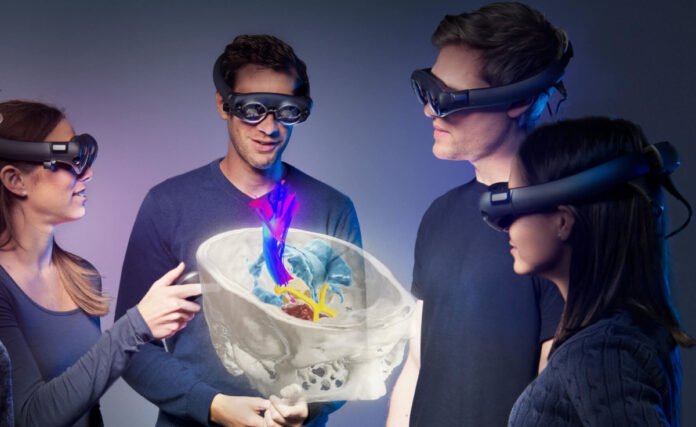Immersive technology has come a long way over the past few decades. From simple 2D computer graphics to the latest virtual and augmented reality technologies, we have seen a massive transformation in the way we interact with digital content. Augmented reality (AR) and virtual reality (VR) are two of the most promising technologies that are set to revolutionize the way we experience digital content.
In this article, we will explore the basics of AR and VR, their potential applications in various industries, and the challenges that need to be overcome to unlock their full potential.
What is Augmented Reality?
Augmented reality (AR) is a technology that overlays digital content on the real world. AR can be experienced through a variety of devices, such as smartphones, tablets, and AR headsets. AR allows users to interact with digital content in a more natural and intuitive way, and it has a wide range of potential applications.
AR can be divided into two categories: marker-based AR and markerless AR. Marker-based AR requires a physical marker, such as a QR code or an image, to trigger the AR experience. Markerless AR uses computer vision algorithms to recognize objects and surfaces in the real world and overlay digital content on them.
What is Virtual Reality?
Virtual reality (VR) is a technology that immerses users in a simulated environment. VR can be experienced through a variety of devices, such as VR headsets and VR-enabled smartphones. VR allows users to experience digital content in a more immersive and interactive way, and it has a wide range of potential applications.
VR can be divided into two categories: mobile VR and tethered VR. Mobile VR uses a smartphone as the display and processing unit, while tethered VR uses a dedicated computer or game console to power the VR experience.
Applications of AR and VR
AR and VR have the potential to revolutionize many industries, from education and entertainment to healthcare and manufacturing. Here are some of the applications of AR and VR:
- Education: AR and VR can be used to create immersive learning experiences, such as virtual field trips and interactive simulations. AR can also be used to enhance textbooks and other educational materials, providing students with a more engaging and interactive learning experience.
- Entertainment: AR and VR can be used to create immersive gaming experiences, such as first-person shooters and puzzle games. VR can also be used to create virtual worlds and experiences that are not possible in the real world.
- Healthcare: AR and VR can be used to create immersive medical training simulations and to help patients manage pain and anxiety. AR can also be used to overlay medical information on a patient’s body, allowing doctors to visualize internal structures in real-time.
- Manufacturing: AR and VR can be used to create immersive training simulations for factory workers and to assist with maintenance and repair tasks. AR can also be used to overlay digital instructions on physical equipment, improving efficiency and reducing errors.
Challenges
While AR and VR have tremendous potential, there are several challenges that need to be overcome to unlock their full potential. Here are some of the challenges facing AR and VR:
- Hardware: AR and VR require specialized hardware, such as headsets and cameras, which can be expensive and bulky. As the technology matures, we can expect to see more affordable and portable devices that can deliver high-quality AR and VR experiences.
- Content Creation: AR and VR require specialized content that can be expensive and time-consuming to create. As the demand for AR and VR content grows, we can expect to see more tools and platforms that make it easier to create and distribute content.
- User Experience: AR and VR can be disorienting and uncomfortable for some users, particularly when they are used for extended periods. Designing user interfaces that are intuitive and comfortable is critical for the successof AR and VR.
- Accessibility: AR and VR can be inaccessible for people with disabilities, particularly those with visual impairments. Ensuring that AR and VR experiences are accessible to everyone is an important challenge that needs to be addressed.
- Privacy and Security: AR and VR raise concerns about privacy and security, particularly when they are used to collect data about users. Ensuring that AR and VR experiences are secure and protect users’ privacy is critical for their adoption.
Conclusion
AR and VR are two of the most promising technologies that are set to revolutionize the way we experience digital content. AR and VR allow users to interact with digital content in a more natural and intuitive way, and they have a wide range of potential applications in various industries, from education and entertainment to healthcare and manufacturing.
While AR and VR have tremendous potential, there are several challenges that need to be overcome to unlock their full potential. Ensuring that AR and VR experiences are affordable, accessible, intuitive, and secure is critical for their adoption. As the technology matures, we can expect to see more affordable and portable devices, more tools and platforms for content creation, and more intuitive user interfaces that make AR and VR more accessible to everyone.
AR and VR are still in their infancy, but they have the potential to change the way we interact with digital content and the world around us. As the technology continues to evolve, we can expect to see more innovative applications of AR and VR that will transform industries and enhance our lives in ways that we can’t even imagine.
Google News | Telegram
















